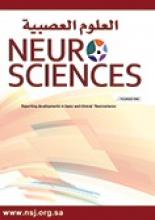Abstract
OBJECTIVE: The objective of this study was to determine the effect of indomethacin on reducing the incidence of intraventricular hemorrhage in premature infants treated in our units at King Faisal Specialist Hospital and Research Centre.
METHODS: This historical cohort study included 45 infants born with birth weights of 1250g or less and received indomethacin in the first 12 hours of life for intraventricular hemorrhage prevention. The treated infants were compared to 33 other infants with birth weights of 1250g or less who did not receive indomethacin for intraventricular hemorrhage prevention. Data collected included demographic, complications of prematurity, renal function and maternal data.
RESULTS: Mean birth weight (grams) and gestational age (week) were 928.4+/-34, 1066.2+/-38.9, 27.2+/-0.37 and 29+/-0.42 for the treated and the control infants. Overall incidence of intraventricular hemorrhage decreased significantly in the treated infants in comparison to the controls (P=0.0169). There was no infant with Grade 3-4 intraventricular hemorrhage found in the treated group while 2 developed grade 3-4 intraventricular in the control group which was insignificant. There were no statistically significant differences between the groups in terms of the complications of prematurity, Apgar scores at 5 minutes, airleak syndrome and the use of umbilical catheters. The total fluid intake in the first 4 days after starting the treatment was comparable between the groups. There were no significant differences between the groups in urine output in day 1, 3 and 4. However the urine output decreased significantly in day 2 in the treated group (P = 0.0349). There were no statistically significant differences in serum urea and creatinine between the groups
CONCLUSION: Low dose indomethacin given in the first 12 hours of life was shown to be associated with a decrease in intraventricular hemorrhage in premature infants and it was not associated with significant adverse effect.
- Copyright: © Neurosciences
Neurosciences is an Open Access journal and articles published are distributed under the terms of the Creative Commons Attribution-NonCommercial License (CC BY-NC). Readers may copy, distribute, and display the work for non-commercial purposes with the proper citation of the original work.






